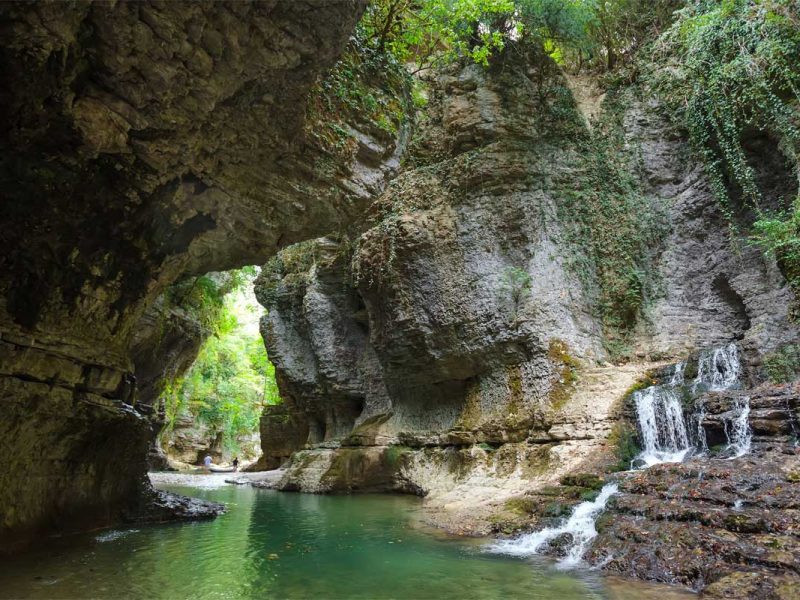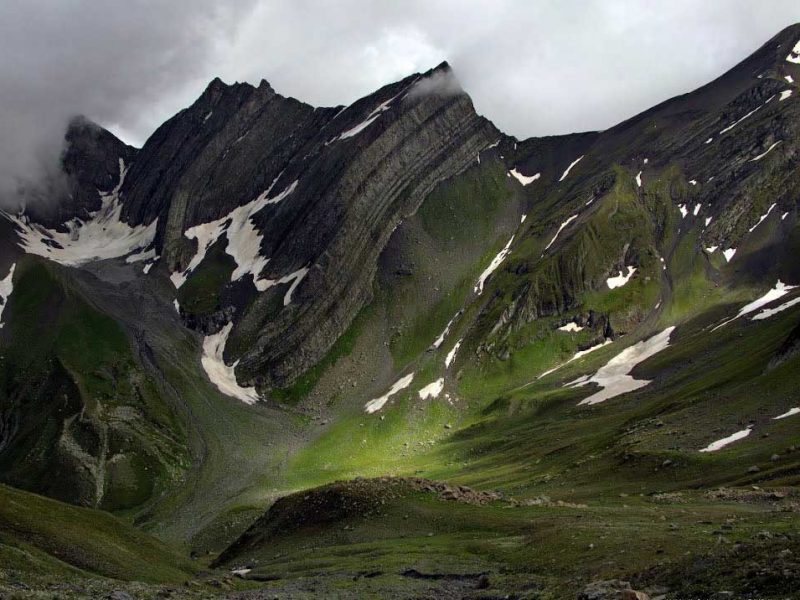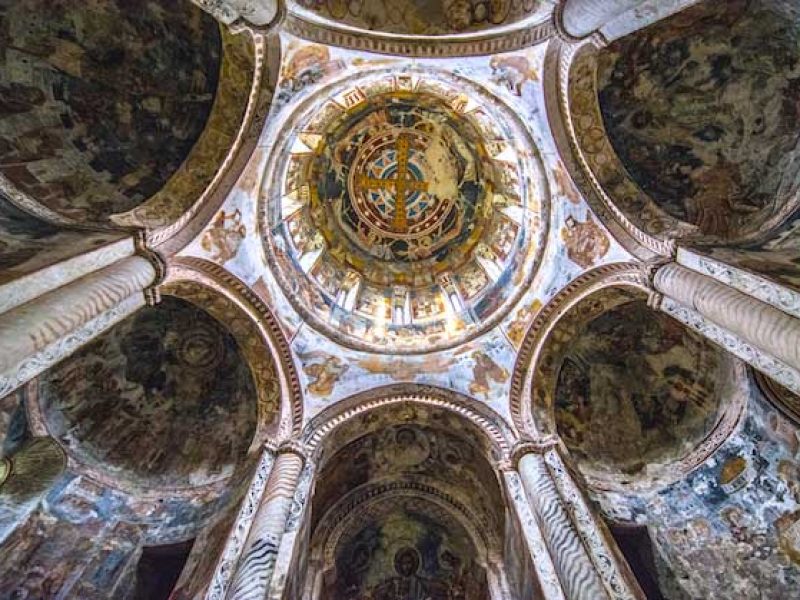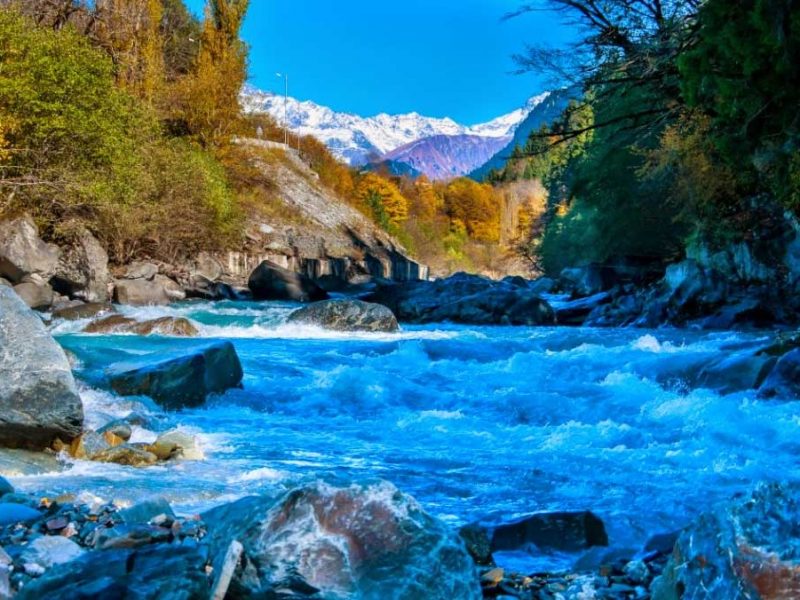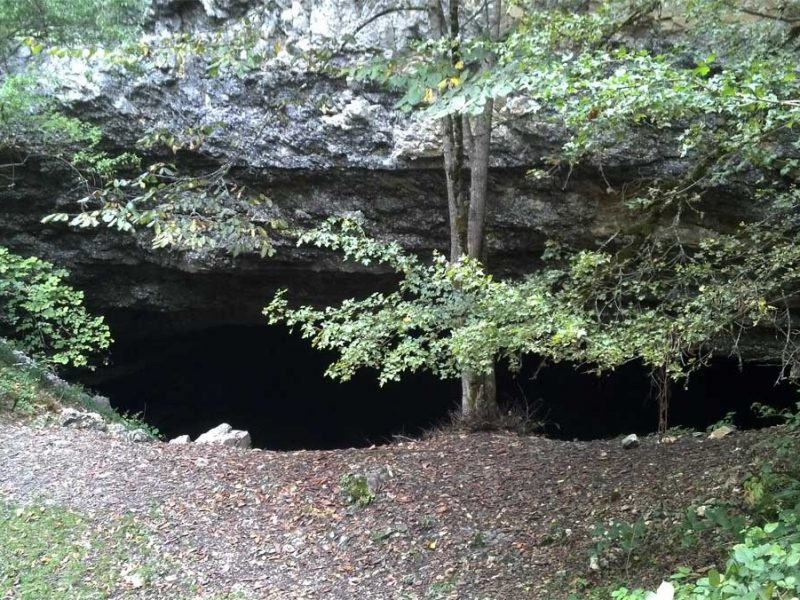Get In touch
If you would like to request more information, please let us know from the contact page
You will be soon contacted by our staff.
Phones: 995 577 191815, 995 596 191911, 995 599 909020
Tbilisi-Racha-Lechkhumi-Samegrelo-
Achara-Imereti-Meskheti-Javakheti
Tour Info – Price 770 EUROS
- Tour can be organized with either SUV or VAN types of vehicle.
- The tour includes: transportation, Accommodation, driver and guide service.
- The tour does not provide meals.
- Tourists are required to bring their own equipment (a tent, backpack, walking stick, sleeping bag).
- If tourists doesn’t have the equipment, our company will help them to rent.
- The minimum number of travelers is 5 people.
- Prices: Tour for 5 people, 770 euros for one person. 20% discount for children (from 3-to 12-year-olds).
Price includes: Transfer, transportation, accommodation, breakfast, driver and guide service.
Tour Program
1st day - Racha
1. Shaori Lake
Shaori Lake, which is the kargest reservoir in the Racha-Lechkhumi and Lower Svaneti region, is located in the Ambrolauri municipality, on the northern slope of Racha Ridge, Shaori basin. It is kept in place by a barrage dam which ponds Shaori River. The reservoir stretches for 7,1 kilometers from south-west to north-east. Its maximum width is 2,7 kilometers, maximum depth – 14,5 meters, average depth -9,8 meters and it covers an area of 9,2 square kilometers. The water volume is 90,6 million m3. It is nourished by tributaries and precipitation. In the vicinity of Shaori reservoir stands the village of Nikortsminda.
2. Nikortsminda cathedral
Nikortsminda is a domed church in the eponomous village of Ambrolauri municipality, at the end of the 10ty century, after creation of Racha Duchy, the first King of unified feudal Georgia, Bagrat III ordered to lay the foundation for a new temple of St. Nicholas, which would later became the cultural of this duchy.
Nikortsminda church is a masterpiece of Georgian architecture. It was built in the 11th century, in the years 1010-1014. This is the period when great attention was paid to decorative design of facades. It is in this respect that Nikortsminda′s decorations are considered an achievement of Georgian architecture. The dome is preserved in its original form.
3. Sakhinule cave
Similar to Imereti, many karstik caves are in the limestone rocks of Racha. The multi-kilometer depths of the Sakinule cave as well as other caves in Ambrolauri region are well-studed.
4. Accommodation (Khotevi, Ambrolauri)
2nd day - Racha
1. Resort Shovi
The village of Shovi is located in Oni municipality, at the altitude of 1 520 m. It is a climatic-balneological resort of national importance, with a humid climate, with a cold winters (average temperature in January is -60C) and cool summers (average temperature in August is 160C). Medical factors: the mountain climate and mineral water that contains carbon, natrium and calcium. In Shovi there are sanatoriums, rest homes, boarding houses, and tourist bases. The holiday season lasts from June to October.
2. Mountain village Glola (mineral/sour tsklebi)
The village of Glola is situated between two mineral resorts of Racha, Utsera and Shovi. Today, this resorts serve domestic and foreign tourists. This places are truly unique, enclosed by coniferous forests and towered by glaciers and summits covered with snow.
3. Mountain-biking (Katitsvera 3129 m, Satsalike 1996 m)
Racha is mostly covered with forests. Green wood sand coniferous forests follow one another. There are also many mixed forests that are especially spectacular in fall. It is an ideal places for resting because of its forests and temperate climate, summits always covered in snow that’s why you can bike around the mountains.
4. Wine degustation pay free, village Sadmeli (Ambrolauri)
The semisweet wine is made of grapes harvested in the so-called “Khvanchkara Zonule”, in several villages in Ambrolauri region. This local exotic and rare wine has always been regarded as a precious present. If a Rachan peasant hosts you with Khvanchkara, it means that he sacrifices the most precious thing that one can find in Racha to you…
5. Accommodation (Ambrolauri)
3rd day - Lechkhumi
1. Borough Tsageri
Lechkhumi consist mainly of Tsageri and several villages in the vicinity. One may say that this part of the world is situated in a basin of rivers. Tsageri is part of foothills rich in forests and rivers. However, some alpine meadows are included in the territory of the region. The mount of the Tsageri is the most in Lechkhumi and in Georgia as a whole.
2. Mountain Khvamli
Khvamli or khomli is a limestone massif in Racha, located in the western part of Lechkhumi, on the territories of Tskaltubo and Tsageri municipalities, at an altitude of 2002 meters. It presents to the south a bluff 300 meters high. It should be noted that caves of Boga and Tekenteri have entrances stemming from this massif, with the latter located in the hollow of a large beech tree. Khvamli is covered with mixed forests.
From encient historical sourses Khomli Mountain is mention as a place that under order of the Zeus (Jupiter) was arrested Prometheus and circuit on the rock, and then was escaped by Herakles. The above-given sourses confirm that the Khomli Mountain has been the object of interest since the oldest times.
3. The horse riding
The horses in this region are typical Georgian mountain horces. friendly, surefooted easygoing and used to walk long distance. Traditionally the horces are decorated with saddles.
4. Overnight stay in tents.
4th day - Samegrelo
1. Nokalaqevi “Tsikhe-goji”
Nokalakevi, also known by its Greek name Archaepolis (Old Town), and by another Georgian name. tsikhegoji, is a historic fortress in western Georgia, located in Senaki municipality. Currently the village of the same name and an archeological site are situated in the vicinity of the fortress.
The place used to be very important Georgian city in ancient times. According to historical sourses, it was built by Kuji, Duke of Egrisi and Svaneti (3rd century BC).
2. Bandza, Holy Virgin of the Assumption (Martvili)
Holy Virgin of the Assumption is a monument dated to VII century. It is a Georgian monastic complex located in village of Bandza. The monastery was strong cultural and education center. there once stood an ancient and enormous oak tree that was worshipped as an idol of fertility. Infants were once sacrificed here as well. After the conversion of the native population to Cristianity, the ancient tree was cut down so as not to worship it anymore.
3. Tsaishi thermal (mineral) waters in Zugdidi
4. Overnight stay in tents
5th day - Samegrelo-Imereti
1. “Village Gachedili” Canyon (Martvili)
Gachedili is a village in Georgia′s Martvili municipality, in Samegrelo-Zemo Svaneti region. It is located on the Odishi plain, at the right bank of Abasha River, 240 meters above sea level.
Gachedili is famous for its 2 400 meters long, and its depth ranges from 20 to 40 m. There is a 12m high waterfall in the middle of it.
The canyon preserves fossilized bones of animals that lived 75 million years ago, making in the world′s third discovery of a territory abundant in such prehistoric remains. This discovery was made in 2010, by graduate students and masters of the institute of Earth Sciences ofllia State University, during field practice. October 4 of the same year, Gachedili canyon was declared a natural reserve.
2. Okatse Canyon, Kinchkha Waterfall (Khoni)
Okatse Canyon is a natural landmark. It is situated in the gorge of Okatse River, close to Zeda Gorda village, in Khoni municipality.
The length of the river is 14 kilometers, the width of the canyon varies from 3 to 15 meters and the depth from 20 to 100 meters. The canyon is adorned by several affluent waterfalls and the length of one of the lakes, Oskhapo, is 60 meters. There also are several natural stony bridges and caves, from which karstic waters flow.
Okatse Canyon Decorated with cascading waterfalls.
The length of the canyon is 2 kilometers and is still not completely studied.
This is a nice place for traveling, camping and night stay too.
3. Drive to the sea (Kobuleti)
Kobuleti stands in a humid subtropical climate zone. Local winters are often warm and without snow, while summers are quite hot, with frequent downpours. The medium annual temperature of the sea near the coast is 16,70c. kobuleti owes its attractiveness of Kobuleti to its orientation towards the sea, diverse natural environment and striving for endless space. Here, everything is subjected to the moderation and harmonic perception of long streets. Todays Kobuleti is a diamond of the Black Sea coast.
4. Accommodation (Kobuleti)
6th day - Adjara
1. “Village Gachedili” Canyon (Martvili)
Gachedili is a village in Georgia′s Martvili municipality, in Samegrelo-Zemo Svaneti region. It is located on the Odishi plain, at the right bank of Abasha River, 240 meters above sea level.
Gachedili is famous for its 2 400 meters long, and its depth ranges from 20 to 40 m. There is a 12m high waterfall in the middle of it.
The canyon preserves fossilized bones of animals that lived 75 million years ago, making in the world′s third discovery of a territory abundant in such prehistoric remains. This discovery was made in 2010, by graduate students and masters of the institute of Earth Sciences ofllia State University, during field practice. October 4 of the same year, Gachedili canyon was declared a natural reserve.
2. Okatse Canyon, Kinchkha Waterfall (Khoni)
Okatse Canyon is a natural landmark. It is situated in the gorge of Okatse River, close to Zeda Gorda village, in Khoni municipality.
The length of the river is 14 kilometers, the width of the canyon varies from 3 to 15 meters and the depth from 20 to 100 meters. The canyon is adorned by several affluent waterfalls and the length of one of the lakes, Oskhapo, is 60 meters. There also are several natural stony bridges and caves, from which karstic waters flow.
Okatse Canyon Decorated with cascading waterfalls.
The length of the canyon is 2 kilometers and is still not completely studied.
1. Kobuleti
Kobuleti is situated at the Black Sea coast, 5 meters above sea level. The town is a part of Kobuleti Plain.
The climate here is soft subtropical, making Kobuleti one of the most popular balneological resorts in the area. During Soviet times, the town was considered one of the most significant regional resorts. Its popularity grew even more over the last decade. For obvious reasons, it became an alternative to the Abkhazian coastline. Kobuleti hosts over 100 000 tourists every summer.
2. Botanical Garden (Batumi)
Batumi Botanical Garden is located at the Green Cape and covers 275 acres of land close to the sea. The Chakvi settlement was created into the so-called Climatization Garden, which today is known by the name of the Upper Garden.
Today, the garden covers approximately a kilometer of the sea fronts southwestern part, between Chakvistskali river outfall and the Green Cape, and stands at 220 meters above the sea level.
The garden is special due to its diverse and very specific physical and geographical conditions. The collection of plants includes over 5 000 species, types and varieties.
3. Gonio Fortress
At Adjaras Black Sea coast, close to the Chorokhi river outfall, there stands a historic fortress. First records mentioning it belong to a Roman author Gaius Plinius Secundus and date back to 1st century AD. Romans and Greeks called this fortress Apsarunt, the name Gonio originated much later, in the 12th century.
Back in the 2nd century, five Roman military cohorts were located here. By the that time, it was a well-consolidated and comfortable walled town. In 1547-1878, Gonio was under Ottoman occupation. It has one gate on each side and eighteen towers.
4. Kvariati Beach
Kvariati Beach is covered with quite clean sand and pebble. the sea in Kvariati as well as in Sarpi crystal clear. There is a lot of convenient hotels, café and restaurants. there is everything that is necessary for the person for beach rest.
5. Sarpi
The village of Sarpi is located in the Khelvachauri municipality and is built along the shores of Tobashi River. Sarpi is close to the Turkish border and accordingly, there is a checkpoint there. Over the last decade, the touristic infrastructure has developed significantly.
6. Accommodation (Kobuleti)
7th day - Imereti-Samtskhe-Javakheti
1.Gelati Monastery (Kutaisi)
Gelati Monastery, this quintessence of Georgian architecture, is one of the most important medieval centers. It is located 11 kilometers to the northeast of Kutaisi, in the gorge through which Tskaltsitela River flows. Its founding is linked to David the builder, the most powerful king of Georgia. The complex consists of various buildings erected between 12th and 13th centuries. Gelati is included into the UNESCO World Heritage Sites list.
Gelati Monastery of the Holy Mother of God stands out for its mosaic paintings performed in 1125-1130. At the center of the church there is a fresco depicting Saint Mary with Baby Jesus in her hands and surrounded with archangels Michael and Gabriel.
This painting is a central part of the whole composition and somehow turned to the right, which creates an impression of natural movement. Gelati mosaic composition, from the artistic point of view, is a typical Georgian creation which has no analogue in medieval art.
2.Bagrati church (Kutaisi)
Bagrati church (knows as cathedral of the Dormition) is located in Kutaisi.
The church was built in 1003, during the reign of Bagrat III. It is a very important monument in medieval Georgian architecture and has a historical as well as symbolic significance .
3.Motsameta church (Tkibuli)
Motsameta was built to immortalize the names of two brothers – David and Konstantine Mkheidze. They were the eristavis (dukes) of Argveti and in the 18th century they had to defend their land against an Arab invasion. Mad with anger, Marwan ordered to torture them, but David and Konstantine withstood the suffering and became martyrs. Their bodies were later laid to rest in the monastery.
4.Prometheus Cave (Tskhaltubo)
Prometheus Cave is located in village Kumistavi (Tskaltubo Municipality) which discovered in Imereti region in 1984. It is one of Georgia’s natural wonders providing visitors with breathtaking examples of stalagmites, stalactites, cave pearls, curtains, petrified waterfalls, underground rivers, and lakes.
5.Borjomi Park, sulfur pools
The climate, the spa resort of Borjomi and its population contributed to the success of the tourism industry. The Borjomi mineral water produced in the gorge turned unto an exportable product and a national brand. Today, the tourist infrastructure of Borjomi is mostly focused on domestic tourism.
The territory belonging to Borjomi is basically regarded a protected territory. The first national park of Georgia, it was founded on the turn of the 20th century. Besides Borjomi Gorge, Borjomi-Kharagauli National Park includes territories of Meskheti and Imereti. Borjomo National Park belong to those rare places still inhabited by herds of the Caucasian noble deer. The tourist positional of Borjomi Gorge and its neighborhood is enormous.
6.Green Monastery (Borjomi)
Green Monastery, officially known as Chitahevi St. George Monastery, is an 9th century friary located in the village of the name, in the Borjomi municipality. According to historians and archeologists, it was built by Chistopher and tevdrore, students od St. Grigol Khancdeli, a very influential figure in Georgian history. The monastery complex includes a basilica-type church and bell tower, also built in 9th century.
The monastery complex people called ˶Green Monasteryˮ, because all the trees in the valley are of a special green color. The stones, with which the church is built, are also green, but some are dark and some are light.
In the 16th century, during the invasions of shah Thamaz, this monastery was raided. During this time dozen of monks were killed or tortured. The blood which remained on the stones thrown into the river Chitakhevi, belong to the monks killed in the 16th century. Bloody stones are spread along almost the entire length of the river running though the territory of the monastery.
7. Overnight stay in tents
8th day - Samtskhe-Javakheti
1.Rabati Fortress
Rabati dates back to the 9th century and occupies seventeen acres. The complex consisted of Jakelis residence, a fortress, a museum anthe ruins of an ancient caravanserai, as well as Greek, Armenian and Catholic churches. A mosque can also be found here. The diversity of the complex is testament to the variety of civilizations in the hands of which it fell over the centuries. Although it is not without great losses that this complex reached our time, today it is fully renovated and differs considerably from what its original look. Even though such a fundamental reconstruction caused mixed responses from the society, one fact cannot be denied:Rabati has become one of the greatest tourist attractions in a Georgia.
2.Cave monastery complex Vardzia
In the southwestern Georgia′s historical Samtskhe-Javakheti region, there is a magnificent monument of Georgian architecture – Vardzia cave monastery complex. It is a 12th-13th century cave monastery complex and fine example of Georgian architecture.
The width of this thirtee-floor ensemble is 500 meters. It is located 1300 meters above sea level and its area is 40 000 square kilometers. Vardzia was a royal monastery from the very beginning.
There are 15 churches inside the Vardzia complex. The most important of them is the Church of Dormition, which was carved out in the center of the complex by the order of Queen Tamar. Its walls were covered in decorations that hold a particular significance for the history of Georgian mural painting. Apart from biblical scenes, there is a unique fresco depicting King George III alongside Queen Tamar and Rati Surameli. It should also be noted that aside from Vardzia the portrait of Queen Tamar can be only found in three more places in Georgia, namely, Kintsvisi, Betania and Bertubani.
In 2007, Vardzia cave monastery complex was included into the UNESCO World Heritage Tentaive List.
3. Accommodation (Tbilisi)
9th day - Mtskheta-Tianeti
1.Gergeti trinity (Kazbegi)
Stepantsminda region is one of the most beautiful parts of Georgia, were situated Gergeti Holy Trinity Church. Time passes and many things change, but there are two things that never alter: the very beautiful local dialect rich in archaisms and the local religious holidays that coincide with the Christian calendar holidays, except the sacrifice ritual that is still pagan. At such festivals al Kazbegians gather. Mariamoba, St. Mary′s Day, is the most important festival celebrated on August 28 at Gergeti Trinity Church. Many sheep are killed during the festival mokhevians living in Tbilisi and other parts of Georgia also come to attend and Khevi is full of people for Mariamoba.
2.Gveleti Waterfall
Gveleti Waterfall is located in Kazbegi municipality. Gveleti Waterfall starts between mountain ranges and overthrown two stages a height of about 25 meters on the Gveletis-tskali. Gveleti means ˶place of snakes ” in Georgian language. This place is considered one of the most popular among travelers.
3.Accommodation (Kazbegi)
10th day - Mtskheta-Tianeti
1.Mountain village Juta, Chiukhvebi, River Snostsxali (Kazbegi)
Mountain village Juta is located in Kazbegi region. The highest this village is 2200 meter from sea level. There are numerous mineral water springs on the territory of Kazbegi municipality. There are many sports with Narzan-type mineral water outlets in the gorges of rivers Snostsxali, Juta and Ukhati. Kazbegi itself also belongs to the resort areas.
2.Accommodation (Tbilisi)








